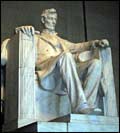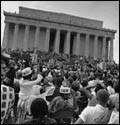 |
Feb. 11, 2002 -- The mere dimensions of the Lincoln Memorial command a certain reverence. Perched atop a three-tiered stack of steps, the base covers roughly the same area as a football field. Thirty-six massive Doric-styled columns surround it. Each is 44 feet high and more than 23 feet around at the base.
Then there's the statue. At 19 feet tall, the seated figure of Abraham Lincoln is almost as imposing as the Memorial itself. Its giant hands, gripping the arms of his chair, look as though they could cradle you comfortably. If the statue could stand, it would reach a towering height of 28 feet.
Looking up from the feet of the statue, whose gaze extends over the Reflecting Pool and on toward the Washington Monument, it's hard to imagine that the Memorial was constructed at all. It almost seems as though it must have existed, fully formed, since the creation of the union itself.
But this is hardly the case. Begun in 1914, after decades of debate, the construction of the Lincoln Memorial took eight years, lasting through a World War.
Bob Edwards reports for Morning Edition, as part of the year-long series Present at the Creation, that this seemingly irreplaceable part of our historical landscape was the source of much debate, and some controversy.
Designing the shell of the Memorial was relatively easy. Architect Henry Bacon's earliest drawings show the influence of Greek architecture. But depicting the president himself proved a more daunting task.
Christopher Thomas is the author of The Lincoln Memorial and American Life, which will be published by Princeton University Press in May. He notes that the most popular image, a standing statue of Lincoln at Grant's Park in Chicago, isn't the one that Bacon ended up choosing.
"Lincoln seems to have sat down and stood up several times in (Bacon's) mind... " Thomas notes. "Because of the reflective, meditative, sad character attributed to his presidency, Lincoln naturally lent himself to being depicted seated."
A more heated disagreement developed over which of Lincoln's memorable roles the Memorial would reflect: Great Emancipator or Savior of the Union? The final decision may have been somewhat politically motivated.
"Lincoln had been a controversial figure for so long in Washington that authorities were deadly afraid of raising any awkward or embarrassing questions," Thomas says, explaining the route they eventually chose -- a focus on Lincoln's efforts to rebuild the broken nation. "Slavery and emancipation are definitely played down."
But this may have been the view favored by Lincoln himself. Harold Holzer, a Lincoln scholar, says that saving the union was the president's priority. "Unless you save the union nothing was possible," he argues. "Democracy wasn't possible. Despotism was inevitable, of which slavery was an example."
The political significance of the site has not been lost over the years. Since its dedication on May 30, 1922, the Lincoln Memorial has played host to many key events, from Martin Luther King Jr.'s "I Have a Dream" speech to Vietnam War protests, the Million Man March and Marian Anderson's famous 1939 Easter Sunday concert from the memorial's steps.
Previous NPR Coverage
 The Lincoln penny
The Lincoln penny
Other Resources
• Learn about the Lincoln statues in Chicago's Grant Park.
• Read a biography of architect Henry Bacon.
• Read about sculptor Daniel Chester French.
• See Theodor Horydczak photos of the Lincoln Memorial.
• Read more about Marian Anderson's 1939 appearance at the Lincoln Memorial.
• See and hear an excerpt of the Rev. Martin Luther King Jr.'s 1963 "I Have a Dream" speech at the Lincoln Memorial (middle of page).
Then there's the statue. At 19 feet tall, the seated figure of Abraham Lincoln is almost as imposing as the Memorial itself. Its giant hands, gripping the arms of his chair, look as though they could cradle you comfortably. If the statue could stand, it would reach a towering height of 28 feet.
Looking up from the feet of the statue, whose gaze extends over the Reflecting Pool and on toward the Washington Monument, it's hard to imagine that the Memorial was constructed at all. It almost seems as though it must have existed, fully formed, since the creation of the union itself.
But this is hardly the case. Begun in 1914, after decades of debate, the construction of the Lincoln Memorial took eight years, lasting through a World War.
Bob Edwards reports for Morning Edition, as part of the year-long series Present at the Creation, that this seemingly irreplaceable part of our historical landscape was the source of much debate, and some controversy.
Designing the shell of the Memorial was relatively easy. Architect Henry Bacon's earliest drawings show the influence of Greek architecture. But depicting the president himself proved a more daunting task.
Christopher Thomas is the author of The Lincoln Memorial and American Life, which will be published by Princeton University Press in May. He notes that the most popular image, a standing statue of Lincoln at Grant's Park in Chicago, isn't the one that Bacon ended up choosing.
"Lincoln seems to have sat down and stood up several times in (Bacon's) mind... " Thomas notes. "Because of the reflective, meditative, sad character attributed to his presidency, Lincoln naturally lent himself to being depicted seated."
A more heated disagreement developed over which of Lincoln's memorable roles the Memorial would reflect: Great Emancipator or Savior of the Union? The final decision may have been somewhat politically motivated.
"Lincoln had been a controversial figure for so long in Washington that authorities were deadly afraid of raising any awkward or embarrassing questions," Thomas says, explaining the route they eventually chose -- a focus on Lincoln's efforts to rebuild the broken nation. "Slavery and emancipation are definitely played down."
But this may have been the view favored by Lincoln himself. Harold Holzer, a Lincoln scholar, says that saving the union was the president's priority. "Unless you save the union nothing was possible," he argues. "Democracy wasn't possible. Despotism was inevitable, of which slavery was an example."
The political significance of the site has not been lost over the years. Since its dedication on May 30, 1922, the Lincoln Memorial has played host to many key events, from Martin Luther King Jr.'s "I Have a Dream" speech to Vietnam War protests, the Million Man March and Marian Anderson's famous 1939 Easter Sunday concert from the memorial's steps.
Previous NPR Coverage
 The Lincoln penny
The Lincoln penny
Other Resources
• Learn about the Lincoln statues in Chicago's Grant Park.
• Read a biography of architect Henry Bacon.
• Read about sculptor Daniel Chester French.
• See Theodor Horydczak photos of the Lincoln Memorial.
• Read more about Marian Anderson's 1939 appearance at the Lincoln Memorial.
• See and hear an excerpt of the Rev. Martin Luther King Jr.'s 1963 "I Have a Dream" speech at the Lincoln Memorial (middle of page).


In sculpting the statue, Daniel Chester French used plaster casts of Lincoln's hands and face, made five years before the president's death.
Photo: Avie Schneider, NPR
 "East Elevation of Lincoln Memorial" by architect Henry Bacon, circa 1910.
"East Elevation of Lincoln Memorial" by architect Henry Bacon, circa 1910.Photo: National Archives
 The Lincoln Memorial played a central role in the 1963 March on Washington.
The Lincoln Memorial played a central role in the 1963 March on Washington.Photo: National Archives
